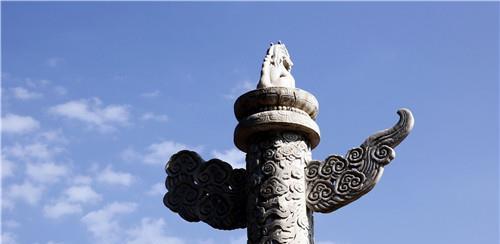Tiananmen, the symbol of the Chinese state, is quietly located in the center of the capital of the People's Republic of China, Beijing, the southern end of the Forbidden City, covering an area of 4800 square meters, it has attracted the attention of the world with its outstanding architectural art and special political status. Founded in 1417 in the Ming Dynasty, it has experienced more than 600 years of ups and downs, and is the pride of our Chinese.
So what are the 2 "big pillars" that have accompanied Tiananmen for more than 500 years? Is it really just decoration?

The "big pillar" is called Huabiao, which is one of the forms of traditional architecture in ancient China, and belongs to the huge stone pillars used for decoration in front of large buildings such as ancient palaces and mausoleums. However, according to historical records, Huabiao's initial use was not decoration.
The Commentary on the Question and Answer of the Present Day records: "Ima no Kamogiya. Cross the pillar head with horizontal wood, and shape it like a flower. Shaped like an orange mallet, the main road intersects with Shi Yan. Or the table wood, to watch the king Na Shuya. Also to express the qu road also. Qin was eliminated, and the Han Dynasty resumed cultivation. Present-day Nishikyo is called the Noonday Wood. ”
The simple explanation is that it can be used as a road sign, but also allow people to "leave a message" on it, write down their own thoughts and opinions, and let the emperor see it, which can be said to be the earliest "opinion box". It was abolished during the Qin Dynasty, restored during the Han Dynasty, and has been used ever since.
The history of Huabiao can be traced back to the Yao Shun era of primitive society, and the history books record that in the Yao period it was called "slanderous wood", with horizontal wood crossed on the pillar head, indicating the direction of the main road, and the Huabiao in front of Tiananmen Still maintained the basic shape of the Yaoshi slanderous wood. It should be noted here that "slander" in ancient times had the meaning of advice, and it was originally a positive word, not the meaning of denigrating others with untrue words now.
So its first use is advice and directions. So what about the second use? Here we can go back to the Huabiao in front of Tiananmen Gate.
Before and after Tiananmen Square in Beijing, there is a pair of Huabiao, also known as "Lookout Pillars", which are very ornate: the pillars are carved with coiled dragons, and on the pillars stand rui beasts, which together with the stone lions in front of Tiananmen Square and the Jinshui Bridge on both sides set off the majesty of the imperial city. What does this "Beast" do?
The "Rui Beast", known as "Stone Beast (hǒu)", is a northern man-eating beast in Chinese mythology and legend, with a crouching posture. If you look closely, you will find that the stone calf in front of the Tiananmen Gate is facing outside the palace, and the stone calf behind the door is facing the palace.
The ancients called the stone calf in front of the door "WangjunGui", which means that the emperor who is looking forward to going out to play will return quickly and return to the palace to deal with major state affairs; the stone calf behind the door is "Wangjun out", exhorting the emperor not to always find fun in the palace, but to often go outside the palace to understand the real life of the people. It's a lot of meaning! Therefore, the second function is to remind the ancient emperors to be diligent and serve the people.
The third role is very simple, that is, to play a decorative role. In ancient times, The Chinese watch was made of wood, and in the Eastern Han Dynasty, it began to be made of stone pillars, and its role changed from vigilance, advice and guidance to decoration.
Huabiao is usually carved from White Jade, the base is square, is a lotus seat or a Sumire seat, which is carved with a dragon pattern, and the dragon pillar is carved on the column, and decorated with flowing clouds; a cloud plate is inserted horizontally at the upper end, called slander wood, which maintains its initial use. At the top is a circular dew plate corresponding to the heavenly circle, on which crouches the divine beast roaring towards the sky (also called Wangtian Roar and Stone Calf).
It turns out that the exquisite and beautiful Huabiao still hides so many historical origins, contains China's profound traditional culture, and embodies the spirit of our Chinese nation!